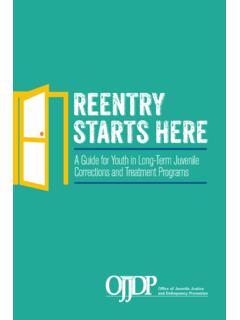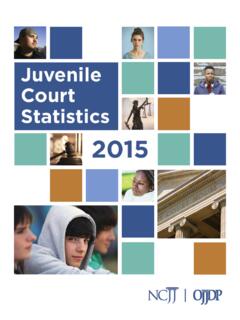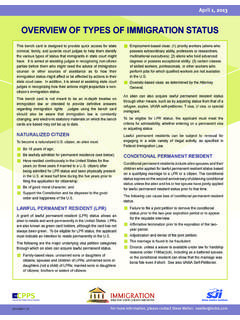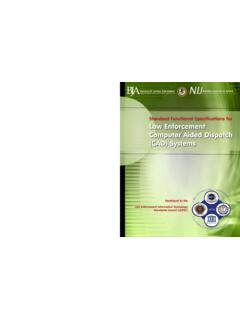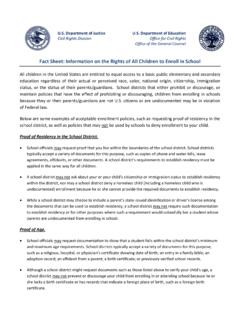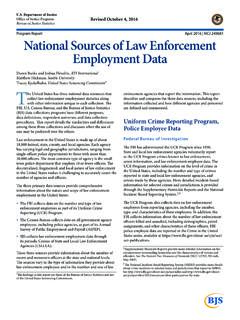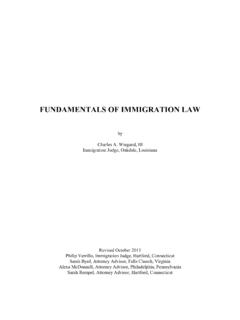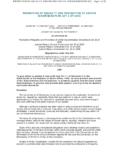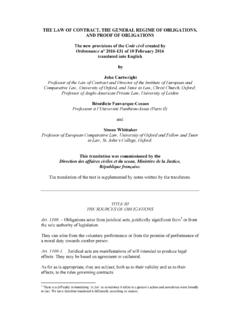Transcription of Last updated: September 2015 www.ojjdp.gov/mpg Status ...
1 Last updated: September 2015 Office of Juvenile justice and Delinquency Prevention 1 Status OffendersA Status offense is a noncriminal act that is considered a law violation only because of a youth s Status as a Typical Status offenses include truancy, running away from home, violating curfew, underage use of alcohol, and general ungovernability. Scope of the Problem Status -offending behavior is often a sign of underlying personal, familial, community, and systemic issues, similar to the risk factors that underlie general offending. Sometimes these underlying issues contribute to delinquency later in life, putting youths at a higher risk for drug use, victimization, engagement in risky behavior, and overall increased potential for physical and mental health issues, including addiction (Greenwood and Turner 2011; Chuang and Wells 2010; Buffington, Dierkhising, and Marsh 2010; Henry, Knight, and Thornberry 2012; Mersky, Topitzes, and Reynolds 2012).
2 Ample evidence supports the notion that less serious forms of delinquency often precede the onset of more serious delinquent acts (Huizinga, Loeber, and Thornberry 1995; Elliott, 1994). However, the precursor to delinquency view of Status offending does not take into account the normal experimentation of childhood and adolescence or the diverse developmental pathways that can lead to serious delinquency (Kelley et al. 1997). Children and adolescents commonly experiment with behaviors that are not considered positive or prosocial, such as lying, being truant, or defying parents. Such experimentation allows youths to discover the negative consequences of their behaviors and learn from their mistakes.
3 Most youths who engage in Status and other minor offenses never progress to more serious behaviors (Kelley et al. 1997). States have formulated differing approaches to defining and handling Status offenders. The approaches can be broadly divided into three categories: Status offenders as delinquents, Status offenders as neglected/abused dependents, or Status offenders as a separate legislative category. The classification of offense behaviors largely dictates the kind of treatment and services that Status offenders are likely to receive. The legal definition of a Status offense is critical, as it can impact the treatment and availability of services to a youth in the juvenile justice system (Kendall 2007).
4 Relatively few states define Status offenses as delinquent behavior under statute, yet many Status offenders end up being treated as de facto delinquents. One such way is through the use of probation as a disposition for Status offenders, which is an option in 30 states (Szymanski 2006). Often, Status offenders will be placed on probation, only to be later incarcerated as the result of a technical 1 The upper age of juvenile delinquency and Status offense jurisdiction varies by state. For more information, please see: Jurisdictional Boundaries (OJJDP, 2014) Suggested Reference: Development Services Group, Inc. 2015. Status Offenders.
5 Literature review. Washington, : Office of Juvenile justice and Delinquency Prevention. Prepared by Development Services Group, Inc., under cooperative agreement number 2013 JF FX K002. Points of view or opinions expressed in this document are those of the author and do not necessarily represent the official position or policies of OJJDP or the Department of justice . Office of Juvenile justice and Delinquency Prevention 2 violation, regardless of whether the Status offense was serious enough to initially warrant the use of confinement (Yeide and Cohen 2009). Federal Legislation: Deinstitutionalization of Status Offenders Although there is significant variation in how states approach Status -offense cases, states receiving federal funding from the Office of Juvenile justice and Delinquency Prevention (OJJDP) are expected to follow the key requirements outlined in the Juvenile justice and Delinquency Prevention Act (JJDP) Act (OJJDP, ).
6 The JJDP Act was passed in 1974 and fostered a federal state partnership for the administration of juvenile justice . In its infancy, the Act set two core requirements that states should abide by to receive federal funding, including the separation of juveniles and adults in incarceration, and the deinstitutionalization of Status offenders (OJJDP, ). The deinstitutionalization of Status offenders (DSO) core requirement of the JJDPA established that youths charged with Status offenses, and/or abused and neglected youths, shall not be placed in secure detention or locked confinement.
7 The intent of this requirement was to encourage states to divert Status -offending youths away from the juvenile justice system and place them in less restrictive, service-intensive, community-based programs. The DSO requirement reinforces the idea that Status offenders should be dealt with differently than juvenile delinquents, and should not be placed in secure detention or correctional facilities. Valid Court Order (VCO) Exception. In 1980, the JJDP Act was amended to include the valid court order (VCO) exception to the DSO requirement, which permits discretion to place a Status offender in detention upon violation of a previously established court order (OJJDP, ).
8 The VCO exception established that Status offenders can be detained if they have violated a direct order from the court, such as attend school regularly or stop violating curfew (Hughes 2011). The use of detention upon violation of a VCO is possible given that all due process requirements have been met, and often serves as a way to hold Status offenders who would not have otherwise been incarcerated. To better understand the due process stipulations, OJJDP created a checklist to help determine when a VCO exception can be claimed (OJJDP ). Thus, violations of a VCO provide an avenue to detention for Status offenders, as allowed by state law (Yeide and Cohen 2009).
9 When a Status offender violates a court order and is incarcerated, his or her offense is then considered a delinquent act and is no longer protected under the DSO requirement of the JJDPA (Kendall 2007; Yeide and Cohen 2009). Use of the VCO is a state-by-state determination, which unfortunately exacerbates disparities in the detention of Status offenders due to inconsistent application across states (OJJDP 2015). A total of 25 states and the District of Columbia allow the VCO exception, which was used with approximately 7,466 juvenile cases in 2014 (OJJDP 2015). Impact of Institutionalization. Research is limited with regard to the specific impacts of institutionalization on particular subgroups, such as Status offenders.
10 However, researchers have examined the general impact of institutionalization on juvenile offenders and consistently demonstrated that confinement in correctional facilities does not reduce reoffending and may increase it for certain youths ( , Lipsey and Cullen 2007). In some cases, Status offenders are placed in the same facilities as juveniles who have committed more serious crimes, a practice that may increase deviant attitudes and behaviors among Status offenders, such as the development of antisocial perspectives and gang affiliation (Levin and Cohen 2014).
